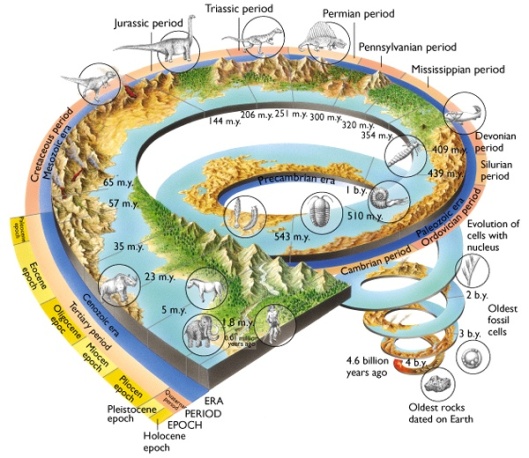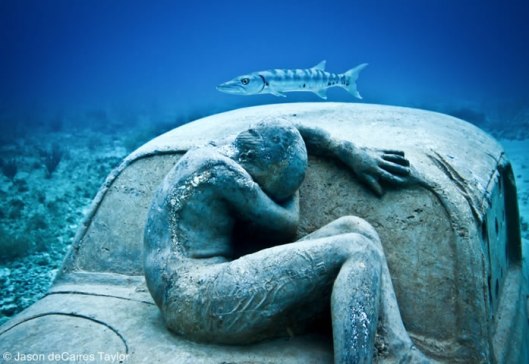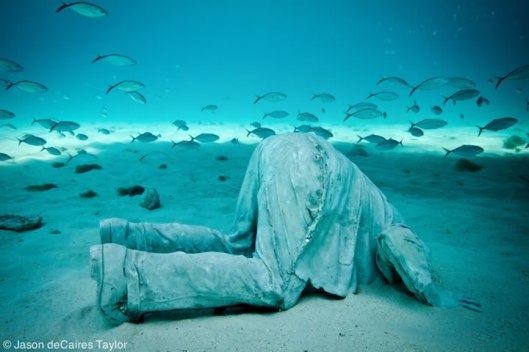The Anthropocene. “Sufficient evidence has emerged of stratigraphically significant change (both elapsed and imminent) for recognition of the Anthropocene—currently a vivid yet informal metaphor of global environmental change—as a new geological epoch to be considered for formalization by international discussion.” [1]
Combining the Greek anthropo– (“human”) with –cene (“new”), the Anthropocene is a popularized term meant to recognize a new geological epoch emerging at the termination of the present Cenozoic Era. Upon first encountering this term during graduate studies in integral ecology, I couldn’t contain my mirth. Naming a geological epoch after our own species? I looked again at the timeline of geological history as it is currently understood (the above graphic) and recognized that anatomically modern humans emerged about 200,000 years ago in the Paleolithic––the tiny sliver there at the end––and I had to ask: Is this a serious proposal?
Perhaps my amusement covered for a deeper sense of despair that the industrialized human would ever awaken to the significance of the rupture in its belonging to a community of life. The consequences of the loss of a planet and a cosmos endowed with inherent meaning and purpose may now only render a nauseating sense of disorientation, armored sarcasm, apathy, or conversely, a toxic nostalgia for the “simpler times” of older authoritarian structures of purpose and meaning. Yet the impact of this dark night of the human soul will not be limited to simple psychological compromise formations or to the human sphere alone.
The phrasing itself seems symbolic of the inflated sense of self-importance which trivializes or renders invisible the needs of the nonhuman world, as well as those humans who are also treated as mere resources or “collateral damage.” I can’t help but see in the term Anthropocene the grandiosity that leads to our present environmental calamity, an arrogance which contributes to the degradation of the Earth’s life support systems and the needless suffering of many lifeforms, including humans.
Eileen Crist has published a wonderfully provocative essay outlining the discourse surrounding the term Anthropocene, which highlights some of the problematic sides of conflating the human being with the Earth process itself. While Brian Swimme and Mary Evelyn Tucker’s assertion that human beings have become a geological force on the planet Earth today [2] seems reasonable, humans are not the only geological force at work. A misconception of the capacity for human management of the living planet can only deepen the trouble which the drive for human domination has brought and carry us further away from the potentials of cooperation and partnership both among species and within our own.
On the Poverty of Our Nomenclature by Eileen Crist, published in Environmental Humanities, vol. 3, 2013, pp. 129 – 147
Highlights of this essay include a romp through the triumphalist narrative of “progress” and its incontestability, i.e., the mythic perception of the fall of humanity from harmony into disharmony with the natural world is excluded from consideration; the sanitization of language which tends to arise in brutal social hierarchies and which is indicative of a “human supremacy complex”; an illustration of the effects of divorcing emotional capacities from the intellectual capacities, such that amassing (or creating) facts can supersede any ethical reflections on moral responsibility; and not only a deconstruction of the Anthropocene discourse but also a constructive proposal for a human presence which is integral to the wild Earth rather than alienated from or at odds with its interdependence with all life. Fortunate it is that humility is not about negation, as the playbook of patriarchy might have it, but rather about full participation and belonging.
REFERENCES
[1] Jan Zalasiewicz, et al. “Are we now living in the Anthropocene,” GSA Today 18(2) (2008): 7.
[2] Brian Swimme and Mary Evelyn Tucker, Journey of the Universe (New Haven: Yale University Press, 2011), 102.



